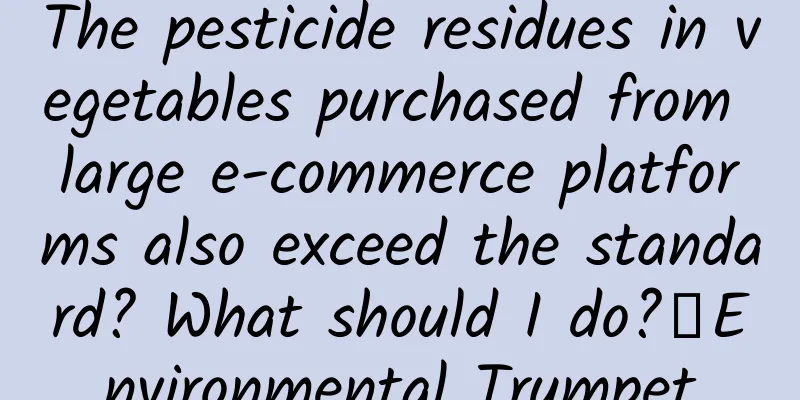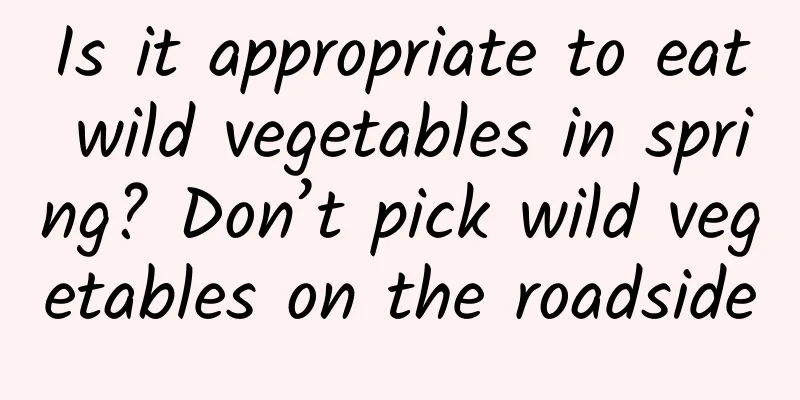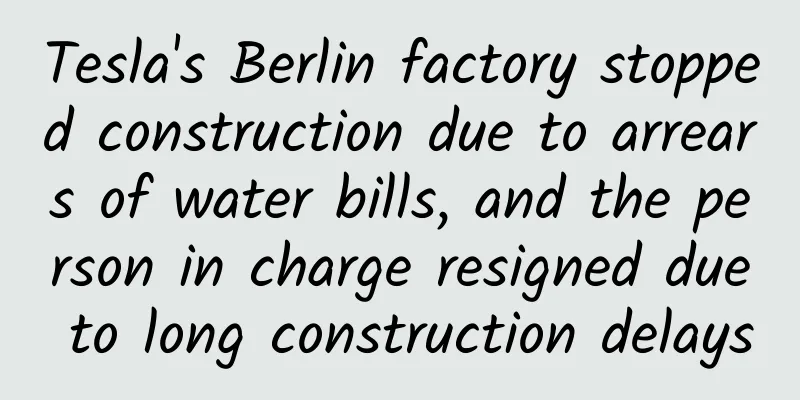The pesticide residues in vegetables purchased from large e-commerce platforms also exceed the standard? What should I do?|Environmental Trumpet

|
Hello everyone, this is the first issue of the Environmental Trumpet column. Our Natural Trumpet column is very popular with readers. In addition to species, we hope to bring more environmental research and news that are worth paying attention to . In this column, you can see different topics such as climate, pollution, energy, agriculture, etc., and learn about how our environment has changed, and what good and bad news there is. In the past half month, we have collected the following environmental research and news worth reading: 1) Pesticide residues in celery on Hema, Meituan and other fresh food platforms exceeded the standard 2) A Chinese team has developed a new type of non-toxic pesticide that is expected to replace paraquat 3) The South Korean government withdraws the ban on the use of disposable products, and environmental protection companies face bankruptcy 4) On November 17, the global average surface temperature was 2°C above pre-industrial levels for the first time 5) The annual carbon emissions of the super-rich 1% are equal to those of the poorer 5 billion people 6) There is a safe and efficient way to recycle used batteries Pesticide residues in celery sold on some fresh food platforms exceed the standard Nowadays, people are more and more accustomed to buying vegetables online and having them delivered to their homes, which is not only convenient but also makes the vegetables look clean. However, these vegetables also have the problem of excessive pesticide residues. On November 28, at the experience exchange meeting on green action of e-commerce food consumption, the public welfare organization "Natural Field" disclosed that they organized consumers to buy beans and celery from multiple e-commerce companies for inspection this year. Among the 36 vegetables inspected, three celery samples were found to have excessive pesticide residues - chlorpyrifos, with the highest exceeding the standard by 55 times . These three celery samples came from Qixian (JD.com), Hema (Ali), and Meituan Maicai . The test results of beans and celery. The pesticide residue in beans is betamethasone, while the pesticide residue in celery is chlorpyrifos | Natural Field According to the List of Prohibited and Restricted Pesticides, the chlorpyrifos found on celery this time is prohibited from being used on vegetables . Chlorpyrifos is highly toxic to fish and aquatic organisms and has a long residual period in the soil. Long-term consumption of food with excessive chlorpyrifos residues will damage your health. Traditional celery planting has a narrow spacing between plants, and the stems and leaves grow vigorously, especially in the middle and late stages of growth, where the environment is shaded and ventilation is poor, and pests and diseases are common . Celery planting also lacks guidance on the precise use of pesticides, so farmers tend to abuse pesticides to control pests based on experience, resulting in excessive pesticide residues in celery. In addition to celery, vegetables such as leeks, beans, and cowpeas are also prone to high levels of pesticide residues. These vegetables have always been the focus of market supervision. In recent years, there have been many incidents where vendors have been fined for selling vegetables with excessive pesticide residues. Celery growing in a greenhouse | Tuchong Creative If you are worried about the excessive pesticide residues in the vegetables and fruits you buy, you can reduce the pesticides through three methods: washing, peeling, and blanching . 1. If you are worried about the excessive pesticide residues in the vegetables and fruits you buy, you can reduce the pesticides through three methods: washing, peeling, and blanching . 2. Wash the fruits and vegetables with running water. If you have baking soda at home, you can also add about a spoonful of baking soda to a basin of water, soak for a few minutes, and then wash with running water. 3. Most pesticides will remain on the skin of fruits and vegetables. For fruits and vegetables with skin, peeling them can reduce the pesticides on the surface, but this will also result in the loss of some nutrients, so you can choose wisely. 4. For stem and leaf vegetables, you can reduce pesticide residues by blanching them. A new type of non-toxic pesticide developed by a Chinese team, Potentially replacing paraquat Paraquat kills weeds quickly, is low-cost, and is non-toxic to plant roots, so it has quickly become one of the most widely used herbicides since it was launched in 1962. However, paraquat is highly toxic to humans and animals, with an oral lethal dose of about 1 to 6 grams for humans. There is no specific antidote, so the clinical mortality rate is high . Recently, Molecular Plant published a Chinese study titled "Diene Diamine: A Safe Herbicide to Replace Paraquat". The research team has developed a new type of non-toxic pesticide, "Diene Diamine", which can retain the same weed control effect as paraquat but is not highly toxic to the human body . It is expected to become a new type of safe herbicide to replace paraquat. Using safer herbicides can not only ensure food security, but also reduce deaths due to paraquat poisoning. South Korean government withdraws ban on disposable items South Korea announced a ban on single-use items, including paper cups, plastic straws and stirrers, in November last year, with a one-year transition period, after which violations will be subject to a fine of up to 3 million won. Various disposable plastic products | Tuchong Creative However, in November this year, the South Korean Ministry of Environment announced the withdrawal of the ban on the use of disposable items , allowing the use of plastic straws in cafes and plastic bags in convenience stores. The South Korean government said this was to alleviate the economic pressure faced by small businesses. However, this move also led to the bankruptcy of environmental protection companies . After South Korea announced a ban on the use of plastic straws, alternative products such as paper straws and degradable straws emerged in an endless stream. After the ban was withdrawn, the sales of some degradable straws plummeted to one-tenth of the original, and returns and cancellations of orders continued. Paper straws are also a substitute for plastic straws | Tuchong Creative According to a 2022 report by the National Academy of Sciences, South Korea's annual per capita plastic waste emissions are 88 kilograms , ranking third in the world after the United States and the United Kingdom. This time South Korea withdrew the ban on the use of disposable items, and South Korean experts are worried that plastic pollution will intensify. On November 17, global temperatures reached 2°C above pre-industrial levels for the first time On November 17, the European Centre for Medium-Range Weather Forecasts (ECMWF) announced that it was the first day that global temperatures exceeded 2°C above pre-industrial levels, and 2.07°C above the 1850-1900 average. The United Nations Environment Programme warned that by the end of this century, the world will have warmed by a "hellish" 3°C . Why are scientists so concerned about the 2°C increase? As early as 1988, American scientist James Hansen believed that human greenhouse gas emissions and global warming were linked and could lead to catastrophic climate change if emissions were not reduced. He was one of the first scientists to publicly link the two. After Hansen's public speech, many scientists began to simulate what would happen to the Earth if the temperature rose by 1°C or 2°C. Studies have shown that if the temperature rises by 2°C, it may lead to more frequent and severe extreme climate events , such as heat waves, floods, hurricanes, etc. These events will pose huge risks to human society, economy and ecosystems. Frequent extreme weather|LEONHARD FOEGER 2°C is a simple principle that can unite people and was frequently mentioned by world leaders in the 1990s when they came together to discuss avoiding climate change. However, it was not until 2010 that the United Nations Climate Change Conference (COP16) wrote 2°C into the international agreement, but there was no clear idea of what to do to achieve this goal. In the 2015 Paris Climate Agreement, countries agreed to develop a plan to limit greenhouse gas emissions, clearly setting 2°C as the upper limit of global warming and 1.5°C as a more ideal goal . Beyond this limit, a series of problems such as rising sea levels, ecosystem collapse, and food supply will overwhelm human society. You can see that it took decades for 2°C to become an official carbon emission target. The speed at which people united to act is far behind the speed of temperature rise. Now, the 28th United Nations Climate Change Conference (COP28) is being held in Dubai . At this conference, the first "global stocktake" is a key topic to compare the progress of climate action by all parties and identify the gaps. COP28 held in oil-rich countries|ESG NEWS The top 1% of the richest people emit the same amount of carbon per year as the poorer 5 billion people Climate change is unfair. The richest people create the most carbon emissions, but have enough money to protect themselves from the risks of climate change, while the poorest people have to bear the pain on the front line of climate change, facing droughts, floods and high temperatures. According to the "Climate Equality" report released by Oxfam Britain and other organizations, the carbon emissions created by the top 1% of the super-rich at the top of the pyramid account for 16% of global carbon emissions , which is the same as the emissions of the 66% of the poor at the bottom of the pyramid (5 billion people). Oxfam's statistics on the relationship between population wealth and carbon emissions in 2019|Climate Equality The report summarizes three key aspects of the rich’s carbon emissions: yachts, private jets and other lavish lifestyles; Investments and shareholdings in heavily polluting industries; Undue influence on the media, economy, politics and policy making. The world is facing the twin crises of climate change and inequality . From an agricultural perspective, extreme weather has severely hampered agricultural production. Today, 783 million people are unsure where their next meal will come from, and in 2020-2021, the richest people in food and agriculture increased their collective wealth by 45%. There is a safe and efficient way to recycle used batteries In addition to mobile phones and computers, more and more waste batteries generated by electric vehicles are piling up. Recycling batteries can not only reuse the metals in waste batteries, but also reduce the pollution caused by batteries to the environment. Current battery recycling technologies focus on pyrometallurgical recycling and wet recycling . Pyrometallurgical recycling mainly involves high-temperature smelting and reduction reactions, and the metals in the battery are recovered in the form of alloys at high temperatures. Wet recycling is the most widely used process in industry, which leaches and separates the metals in the battery. In chemical treatment, if harmful chemical reagents are used, it is not only dangerous during the operation, but also causes environmental pollution . Researchers at the U.S. Department of Energy's Oak Ridge National Laboratory have developed a simple and efficient method - using citric acid . ORNL researchers Lu Yu and Yaocai Bai examine vials containing a chemical solution that separates cobalt and lithium from spent batteries. | Carlos Jones/ORNL, US Dept. of Energy Citric acid, which is commonly found in citrus fruits, can be used to separate cobalt and lithium by mixing it with ethylene glycol, an antifreeze commonly found in cosmetics, to soak spent batteries. This solvent is safer to handle than mineral acids and is more environmentally friendly. “The cathode of a battery contains critical materials, so it is the most expensive part of any battery, accounting for more than 30 percent of the cost,” said Yaocai Bai, a member of the ORNL battery research team. The research was conducted at Oak Ridge National Laboratory's battery manufacturing facility, the largest open battery manufacturing R&D center in the U.S. The recycling technology developed here can leach nearly 100% of the cobalt and lithium from the cathode, effectively separating the metals from other residues. Using sustainable and safe solvents can not only reduce costs but also avoid the generation of secondary waste . For ordinary people like us, if we have a pile of waste batteries on hand, we can check whether they are mercury-free carbon dry batteries. At present, almost all dry batteries used in life have achieved mercury-free and can be thrown directly with other dry garbage . Mercury-free dry cell batteries|Pixabay In addition to dry batteries, other batteries - such as lithium batteries removed from mobile phones, lead-acid batteries used in some electric vehicles, and button batteries - are generally treated as hazardous waste . References [1] Celery sent by consumers for inspection was found to have 55 times the limit of chlorpyrifos! Involving Qixian, Hema Fresh, and Meituan Waimai https://mp.weixin.qq.com/s/2nw99d3-TrZjFMuOgDAodg [2] How to clean various types of food? https://www.guokr.com/article/443200/ [3] List of banned and restricted pesticides http://www.moa.gov.cn/xw/bmdt/201911/t20191129_6332604.htm [4] Zhuo Fuyan, Li Ping, Wu Qingjun. Characteristics of the main diseases and pests of celery in my country and integrated green prevention and control technology[J]. Chinese Vegetables, 2023, (05): 117-119. [5] Shanghai Institute of Organic Chemistry jointly developed diethylenediamine: a safe herbicide that is expected to replace paraquat http://www.sioc.cas.cn/news/kjdt/202311/t20231114_6932836.html [6] Wang Yuhua. Analysis of medical records of 47 cases of paraquat poisoning[J]. Journal of Shandong Medical College, 2020, 42(03): 232-233. Peng, H., Zhao, D., Tang, W., & Peng, A. (2023). Dienediamine: A Safe Herbicide as Paraquat Surrogate. Molecular Plant. [7]South Korea retracts ban on disposable cups at cafes, restaurants https://www.straitstimes.com/asia/east-asia/south-korea-retracts-bans-on-disposable-cups-at-cafes-restaurants?close=true [8]South Korea suspends plastic straw ban to ease small business' economic burden https://koreapro.org/2023/11/south-korea-suspends-plastic-straw-ban-to-ease-small-business-economic-burden/ [9]Reckoning with the US Role in Global Ocean Plastic Waste https://nap.nationalacademies.org/catalog/26132/reckoning-with-the-us-role-in-global-ocean-plastic-waste [10]https://twitter.com/CopernicusECMWF/status/1726578518463816078 [11]In September we went past 1.5 degrees. In November, we tipped over 2 degrees for the first time. What's going on? https://theconversation.com/in-september-we-went-past-1-5-degrees-in-november-we-tipped-over-2-degrees-for-the-first-time-whats-going-on-218228 [12]Climate Equality: A planet for the 99% https://www.oxfam.org/en/research/climate-equality-planet-99 [13] Yin Yixiong, Ren Yongsheng, Ma Wenhui, Lei Yun, Wu Jijun, Li Shaoyuan, Wei Kuixian, Zhan Shu. Research status of recycling technology of cathode materials of spent lithium-ion batteries[J]. The Chinese Journal of Nonferrous Metals, [14]Greener solution powers new method for lithium-ion battery recycling https://www.sciencedaily.com/releases/2023/11/231129112422.htm [15] I have a lot of used batteries. Can I throw them in the trash? https://mp.weixin.qq.com/s/qz12P_qT59UE1Q5fWOOEOQ Author: Austenite Editor: Little Towel, Mai Mai Title image source: Hema This article comes from GuokrNature (ID: GuokrNature) |
>>: Why does iced cola taste better when eating hot pot?
Recommend
Why does adding the symbol “~” during a chat create a cheerful feeling?
Although punctuation marks are small, their selec...
Toyota plans to launch solid-state batteries in ten years, with a range of 500km after 10 minutes of charging, and the prototype will be unveiled next year
It only takes 10 minutes to charge from 0 to 100%...
7 key points you must know when starting to operate Douyin
I have summarized and sorted out some universal a...
WP ≠ Lumia
Since Microsoft officially released WP7, the WP c...
Information flow advertising | Learn the correct method to increase exposure!
My friends, I believe many of you are worried abo...
What are the functions of the photography applet? How much does it cost to create a professional photography app?
Everyone's exposure to photography is differen...
SAIF & Industrial Securities: 2024 China Carbon Market System Research Report
Carbon emission quotas are one of the basic tradi...
Let me tell you about an exciting animal... (screaming the whole time)
Addendum 1: Many people may have heard of this me...
International Federation of Robotics: World Robotics Report 2020
The new World Robotics 2020 Industrial Robots rep...
How to manage an event well?
The content of this article is very dry, so it is...
A deer with plum blossoms on its face may not necessarily be a sika deer
When we talk about "biological invasion"...
"Transformation" and "crossover" under the new situation allow home appliances to better understand people's hearts!
Preface Affected by the novel coronavirus pneumon...
How can community apps perform good product operations? 13 ways to promote community applications!
The key to the early success of community product...
Do you always want to slack off at work? Scientists: Your brain needs to detox!
This week for workers It's been a long week T...
Changsi Advertising makes full efforts to help "Fishing Master 3" win the championship again
Mobile advertising revenue will reach 31.5 billio...









